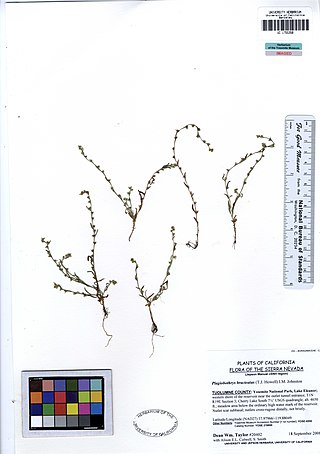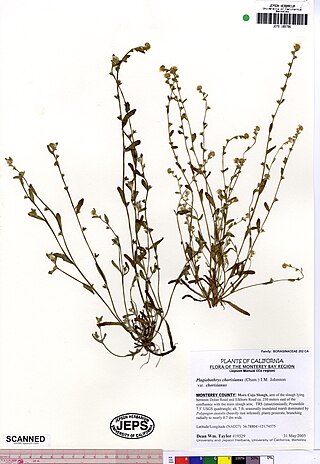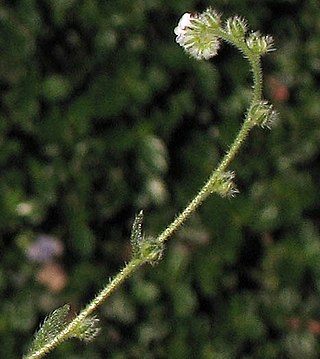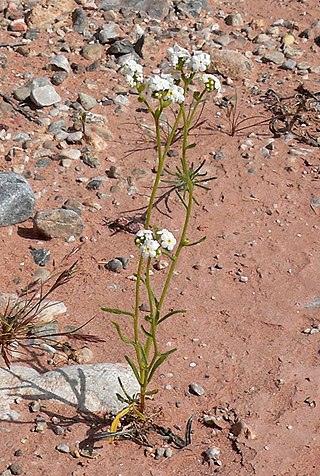
Lupinus arizonicus, the Arizona lupine, is a flowering plant in the legume family Fabaceae, native to the Mojave and Sonoran Deserts of North America, where it can be found growing in open places and sandy washes below 1,100 metres (3,600 ft) elevation. It is common around Joshua Tree National Park and Death Valley National Park in California.

Plagiobothrys is a genus of flowering plants known commonly as popcorn flowers. These are small herbaceous plants which bear tiny white or yellow flowers. Their fruits are nutlets. Although these plants are found predominantly in North America and South America, five species are known from Australia. Of the approximately 65 species described, more than 15 are endemic to California.

Echinocereus triglochidiatus is a species of hedgehog cactus known by several common names, including kingcup cactus, claretcup, and Mojave mound cactus. This cactus is native to the southwestern United States and northern Mexico, where it is a resident of varied habitats from low desert to rocky slopes, scrub, and mountain woodland. It is most abundant in shady areas.

Plagiobothrys acanthocarpus is a species of flowering plant in the borage family known by the common name adobe popcornflower. It is native to California and northwestern sections of Mexico, where it can be found in moist areas on clay soil, such as vernal pools. It is an annual herb with a spreading or erect stem 10 to 40 centimeters in length. The leaves are linear or lance-shaped to oblong and several centimeters in length. The plant is coated in rough hairs. The inflorescence is a series of tiny flowers, each with a yellow-throated, five-lobed white corolla less than 3 millimeters wide. The nutlets are covered in long prickles with some bristles between.
Plagiobothrys austiniae is a species of flowering plant in the borage family known by the common name Austin's popcornflower. It is native to California, where it can be found in the Central Valley and Sierra Nevada foothills. It is also known from southern Oregon.

Plagiobothrys bracteatus is a species of flowering plant in the borage family known by the common name bracted popcornflower.

Plagiobothrys canescens is a species of flowering plant in the borage family known by the common name valley popcornflower. It is endemic to California, where it is a common wildflower in valley, foothill, desert, coastline, and canyon habitat in the central and southern regions of the state.

Plagiobothrys chorisianus is a species of flowering plant in the borage family known by the common name artist's popcornflower. It is endemic to California, where it can be found in and around the San Francisco Bay Area and parts of the coastline to the south.

Plagiobothrys collinus is a species of flowering plant in the borage family known by the common name Cooper's popcornflower.
Plagiobothrys distantiflorus is a species of flowering plant in the borage family known by the common name California popcornflower. It is endemic to California, where it is known only from the northern and central Sierra Nevada foothills.

Plagiobothrys fulvus is a species of flowering plant in the borage family known by the common names field popcornflower or fulvous popcornflower. It is native to California and Oregon in the United States, as well as Chile.
Plagiobothrys humistratus is a species of flowering plant in the borage family known by the common names dwarf popcornflower or low popcornflower. It is endemic to the Central Valley of California, where it grows in grassland habitats, including vernal pools and other wetland areas.

Plagiobothrys jonesii is a species of flowering plant in the borage family known by the common name Mojave popcornflower. It is native to the southwestern United States and northern Mexico, where it grows in desert mountains and flats in scrub and woodland habitat.
Plagiobothrys kingii is a species of flowering plant in the borage family known by the common name Great Basin popcornflower. It is native to the Great Basin and Mojave Desert of the United States, where it grows in desert and plateau scrub habitat, among saltbush and on rocky slopes and flats.

Plagiobothrys nothofulvus is a species of flowering plant in the family Boraginaceae known by the common names rusty popcornflower and foothill snowdrops. It is native to western North America from Washington, and California, to northern Mexico. It is a spring wildflower in grassy meadows, woodlands, coastal sage scrub, and wetland-riparian habitats.
Plagiobothrys parishii, known by the common name Parish's popcornflower, is an uncommon species of flowering plant in the borage family.

Plagiobothrys stipitatus is a species of flowering plant in the borage family known by the common name stalked popcornflower and stipitate forget-me-not. It is native to Oregon and most of California, where it grows in vernal pools and similar wet habitat types. It is an annual herb producing a narrow, hollow, erect stem up to half a meter tall. It is coated in rough hairs. The pointed, hairy leaves along the stem are up to 11 centimeters long. The inflorescence is a series of five-lobed white flowers 2 millimeters to over one centimeter wide. The fruit is a narrow, ribbed nutlet.
Plagiobothrys uncinatus is a species of flowering plant in the borage family known by the common names Salinas Valley popcornflower and hooked popcornflower. It is endemic to the Central Coast Ranges of California, where it is known mainly from the Santa Lucia Mountains and Gabilan Range in Monterey County.

Echinocereus arizonicus is a species of cactus native to the Chihuahuan Desert region of Chihuahua, southwestern New Mexico and southeastern Arizona, as well as in the Superstition and Mescal Mountains of Central Arizona. An endangered variable of the species "Echinocereus triglochidiatus arizonicus" is found exclusively in sections of the Superstition, Mescal, and Pinal Mountains. Genetic studies have indicated that this variable of the species does not occur outside these mountain ranges.
Coreocarpus arizonicus, the little lemonhead, is a North American species of flowering plants in the daisy family native to northwestern Mexico and the southwestern United States. It has been found in southern Arizona, and in the adjacent Mexican States of Sonora, Chihuahua, Sinaloa, and Baja California Sur.














